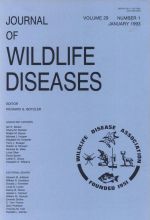Efficacy of cleaning Baermann apparati was evaluated to determine if larvae are retained on glassware after evaluating white-tailed deer (Odocoileus virginianus) fecal samples containing Parelaphostrongylus tenuis. Residual P. tenuis larvae were recovered from 7 (11.7%) of 60 Baermann apparati cleaned with soap and tap water. Of 295 moose (Alces alces) fecal samples collected in central and northern Maine, only one contained protostrongylid larvae. Our data do not support the hypothesis that recent increases in Maine’s moose population can be attributed to moose becoming a suitable host to P. tenuis.
How to translate text using browser tools
1 January 1993
Parelaphostrongylus tenuis in Maine Moose and the Possible Influence of Faulty Baermann Procedures
Mark A. McCollough,
Kathy A. Pollard

Journal of Wildlife Diseases
Vol. 29 • No. 1
January 1993
Vol. 29 • No. 1
January 1993
Alces alces
Baermann technique
Maine
moose
Parelaphostrongylus tenuis meningeal worm




